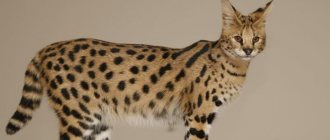Tigers: description
Tigers are one of the largest predatory animals in the Felidae family. Moreover, almost all subspecies of this family are large and strong predators, which in terms of weight are second only to bears.
Appearance
Tigers are quite strong, hardy and massive wild cats. Despite this fact, depending on the subspecies, the weight of wild cats can vary, although slightly, as can the color of their coat. It should be noted that wild cats living on the mainland are always larger than their relatives living on the islands. The Amur tiger and the Bengal tiger are considered the largest animals of this family, although recently the Amur tiger has begun to give primacy in size to its Bengal counterpart. Adults, especially males, grow to almost 3 meters in length and can weigh almost 300 kilograms.
The height of the predator at the withers is more than a meter. The body of the predator is distinguished by its elongated shape, while it is flexible and muscular, although the front part of the body is much better developed than the back.
We can say that the tiger's tail is long, covered with hair just like its body. On the tail there are transverse stripes of black color so that they form rings, while the tip of the tail is always black. On each front paw of powerful limbs there are up to 5 fingers, while on the hind paws you can count 4 fingers. All paws are armed with tenacious and sharp retractable claws.
The head is large and has a rounded shape, as well as a protruding facial part and a convex frontal part. The skull is powerful, and the cheekbones are widely spaced, extending onto the maxillary bones of the nasal bones. We can say that this large animal has relatively small ears, with rounded ends. There are distinct sideburns on both sides of the head.
The vibrissae are quite elastic, arranged in 4 or 5 rows and are distinguished by their white color. Their thickness reaches one and a half millimeters, with a length of more than 150 mm. The pupils are round, and the iris of the eyes has a yellow tint. All adult individuals, regardless of species, have up to 3 dozen strong and sharp teeth in their mouths.
Interesting to know! The male leaves behind larger and more elongated tracks compared to females. In this case, the middle fingers protrude noticeably forward compared to the side ones. The mark left by the male is about 160 mm long and about 140 mm wide, and the female leaves a trail about 150 mm long and about 130 mm wide.
Predators living in warmer regions have a thin and very sparse coat of fur, although it is quite dense. Tigers that live in colder regions have long, fluffy fur. The basic color of the coat can vary from rusty-reddish to rusty-brown. As a rule, lighter tones, almost white, are observed in the abdomen, chest, and inner surfaces of the paws.
There is also a light tint on the ears, especially on the back side. On the entire body and on the neck there are stripes located in the transverse plane, and there are significantly more such stripes on the back of the body compared to the front. Below the level of the nostrils, in the vibrissae area, as well as the chin and lower jaw, white color dominates. On the forehead, in the area of the back of the head and the crown of the head, one can see a rather complex and variable pattern, which is formed due to the presence of black stripes.
The shape of the stripes, the width and distance between them depend on the type of animal included in this family. In any case, there are at least hundreds of such stripes on the predator’s body. If all the fur is removed from an animal, the striped pattern also appears on the skin of the predator, so the pattern will repeat itself if all the fur grows back.
Behavior and lifestyle
Regardless of the subspecies, all tigers are pronounced territorial predators that lead an isolated lifestyle, hunting in a certain territory. They can have an individual plot of up to one hundred square kilometers. This territory is always protected by the male from his relatives, and fiercely. Despite this, several females can live in the territory of a male without any problems.
Due to their massiveness, which does not allow them to pursue their prey for a long time, tigers hunt from ambush, making lightning-fast speed dashes. If it was not possible to catch prey at one time at a short distance, the tiger does not pursue it and prepares to catch the next prey.
Tigers hunt in two ways: they can quietly and unnoticed sneak up on their prey or wait in ambush. When the distance between the tiger and the animal is reduced to about 150 meters, then the predator makes its decisive push.
Interesting to know! Tigers are capable of jumping up to 5 meters high and at least 10 meters long.
Attacks on frightened animals are so fast that the victim has no chance of escape. No animal is capable of gaining such speed with lightning speed as to evade an attack, although even a tiger is capable of missing. Males can easily share their prey, but only with females.
How long do tigers live?
The largest Amur tigers can live in the wild for about 15 years, but in captivity - a little more, about 20 years. Bengal tigers live almost the same amount, although in an artificial environment they can live for about half a century. Indochinese, Sumatran and Chinese tigers live in their natural environment for up to 18 years. The Malayan tiger lives the longest in the wild, almost half a century, and in captivity it is 5 years longer. Of course, this is possible provided that proper conditions are created.
TIGER - INTERESTING FACTS
Origin of the Cat Family
It is reliably known that the first wild cats appeared on the planet during the Miocene period. The first species of the cat family, Proailurus, lived on the territory of modern Asia and Europe. It was from him that all other varieties of these animals subsequently descended. This ancient mammal had an elongated body, small paws and a very long tail. The main weapons of this predator were its sharp teeth and claws.
Scientists believe that Proailurus is the ancestor of a more modern animal, Pseudelurus, which lived on Earth about 20 million years ago. It had a more typical appearance for the cat family and was found not only in Europe and Asia, but also in North America. This predator had a flexible, slender body and powerful muscular legs. Pseudelurus spent most of its life in trees.
Later, about 2.5 million years ago, Smilodon appeared, which scientists also classify as ancient wild cats. These animals were similar in color to the modern snow leopard.
Types of tigers with photos and names
Scientists know of only nine subspecies that belong to the “Tiger” species, although humans have currently been able to preserve only six of them. The preserved species of "Tigers" include:
Amur tiger (Panthera tigris altaica)
Which has a lot of names - Ussuri tiger, North Chinese, Manchurian or Siberian. The Amur tiger mainly lives in the Amur region, within the Jewish Autonomous Okrug, in the Primorsky and Khabarovsk territories. It is considered the largest subspecies, which has a fairly thick and fluffy coat, as well as very long hair. The color is predominantly dull, red, with a minimal number of black stripes.
Bengal tiger (Panthera tigris tigris)
Which belongs to the subspecies of tigers found in countries such as Pakistan, India, Bangladesh, Nepal, Myanmar and Bhutan. Bengal tigers are found almost everywhere in these countries, from jungles or mangroves to dry savannah. Males can gain weight up to 230 kilograms, and females - no more than 150 kilograms. It should be noted that tigers living in the northern regions of India and Nepal are more massive compared to those living in other parts of the Indian subcontinent.
Indochinese tiger (Panthera tigris corbetti)
Which is found in Cambodia and Myanmar, Southern China, Laos, Thailand, Malaysia and Vietnam. This subspecies has a darker coat color. Compared to the Bengal tiger, males of this species are slightly short of 200 kilograms, and females - up to 140 kilograms.
Malayan tiger (Panthera tigris jacksoni)
Which represents the smallest subspecies, since its weight reaches no more than 130 kilograms, and females barely reach 100 kilograms. Their small size allows these predators to thrive in the jungles of Sumatra.
Sumatran tiger (Panthera tigris sumatrae)
The smallest of the existing subspecies. An adult male weighs approximately 100-130 kg, and the weight of females does not exceed 90 kg.
Chinese tiger (Panthera tigris amoyensis)
Which is slightly larger in size compared to the Malayan tiger. The weight of adult males reaches almost 180 kilograms, with a body length of 2 and a half meters. This subspecies does not have much genetic diversity.
Subspecies such as the Bali tiger, Transcaucasian tiger and Javan tiger are considered extinct, while fossil subspecies include Panthera tigris acutidens, as well as the Trinil tiger.
Interesting fact! As a result of mating of the Amur and Bengal subspecies, a hybrid was born. It is also known about the “liger”, as a hybrid that appeared after the mating of a lion and a tigress, as well as about the “tiger lion”, when a tiger and a lioness were mated.
Who is considered the smallest of the wild cats?
Rusty cat The smallest wild cat lives in Sri Lanka and South India. This breed is called a red or rusty cat. Kids prefer to stay close to trees all the time. Among the dense branches they find food for themselves - bird eggs, insects, chicks. The size of a miniature cat is only 80 cm including the tail. Red predators weigh no more than one and a half kilograms.
Natural habitats
Not so long ago, tigers were widespread throughout the Asian continent.
What is characteristic of our time is that these predators are preserved only in 16 countries of the world:
- In Laos.
- In Bangladesh.
- In the Republic of the Union of Myanmar.
- In Bhutan.
- In Cambodia.
- In the Socialist Republic of Vietnam.
- In Russia.
- In the Republic of India.
- In the Islamic Republic of Iran.
- In the Republic of Indonesia.
- In China.
- In Malaysia.
- In the Islamic Republic of Pakistan.
- In Thailand.
- In the Federal Democratic Republic of Nepal.
As a rule, the natural habitats of tigers are the northern regions of the taiga, areas characterized as semi-deserts, as well as forest areas, dry savannas and humid tropics.
Important point! Most wild cats are afraid of water, so they try to avoid various bodies of water, regardless of their depth. Tigers are predators who swim well and enjoy swimming in it. This is how they escape from insects and heat.
In order to hunt effectively and reproduce, tigers prefer steep cliffs with numerous niches and hidden caves. They also feel great in reed and reed thickets located near water bodies.
Dune cat
The nimble inhabitant of the deserts of Africa and the Arabian Peninsula belongs to the subspecies of small cats and is the smallest wild cat in the family. In size, the dune (or sand) cat is smaller than many domestic breeds. An adult male reaches a length of 70-85 cm, of which almost half is the tail.
Sand cats live in the most inaccessible places on Earth - waterless sand dunes of the desert with temperatures up to 55-60 C. Predators adhere to a nocturnal lifestyle and only leave their burrows at nightfall. In search of food, they are able to cover distances of 10 km, while developing speeds of up to 40 km/h. Interestingly, their original hunting tactics allow them to emerge victorious in fights even with dangerous snakes, for example, horned vipers.
Predator diet
Since all subspecies of tigers are carnivorous mammals, their diet consists exclusively of food items of animal origin. The only thing is that the diet of such animals depends on the characteristics of their habitat, as well as the availability of food supply. If we take the Bengal tiger's diet as an example, the main source of food is wild boars, Indian sambars, nilgais and axis. As for Sumatran tigers, their main prey are wild boars, tapirs and sambar deer. The diet of Amur tigers includes: musk deer, sika and red deer, including roe deer and wild boar.
The diet of tigers can include Indian buffaloes, as well as elk, pheasants, hares, monkeys, and in some cases fish. In hungry years, these predators eat frogs, various rodents and other small animals, including berries and the fruits of some wild plants. It is also known that adult individuals, if such an opportunity arises, can easily attack other predators, such as leopards, crocodiles, wolves, boa constrictors, including bears that live within a certain biotope.
Seasoned males, who are distinguished by their incredible size and strength, enter into a duel with bears. Despite this, such fights are always unpredictable, since bears are also quite powerful predators. According to some reports, tigers often attack Indian elephant cubs. Therefore, zoos are very attentive to the process of shaping the diet of tigers. Here it is important to adhere to the recommendations of specialists from the Euro-Asian Regional Association.
In any case, it is necessary to take into account the age of this animal, its weight, gender, as well as the season. In addition, it is necessary to pay attention to the fact that the tiger’s diet is varied, including chicken and beef. In addition, the diet should be diversified by including milk, eggs, fish, and other food items with sufficient protein capacity.
In order for a predator to be satisfied and not feel hungry, it must eat about 10 kg of meat per day. At the same time, the consumption rate may vary depending on age, which is associated with its size. As for other products, they are given to the predator in limited quantities to maintain the balance of useful components. When a tiger is in captivity, the diet should include vitamin supplements and healthy supplements containing useful minerals that can prevent the development of rickets in the animal.
TIGER IN ACTION! Tiger against bear, crocodile, elephant, wild boar...
Pinnipeds
Pinnipeds were previously classified as a separate order, but now they belong to the order of carnivores in the form of three families: walruses (one modern species), true seals and eared seals. Let's look at several species of this group of marine mammals. They are quite similar to each other due to the monotony of their living environment - the aquatic environment. Pinnipeds descend from terrestrial carnivores. In the process of evolution, the limbs turned into flippers. The largest representative is the sea lion, or Steller's sea lion. The weight of males reaches 1 ton.
Sea lions
Seals are much smaller and weigh 200–300 kg.
Seals
Pinnipeds feed on fish and marine crustaceans. They live in cold and warm waters. During the breeding season, they gather on land in huge rookeries.
Walrus rookery
The monk seal got its name due to its solitary lifestyle. This is the only seal species living in the Black Sea. These animals are extremely rare and are carefully protected by all countries of the Black Sea region.
White-bellied seal (monk)
Reproduction and offspring
Tigers, regardless of subspecies, are considered polygamous mammals. Their mating season begins in December and can last a month or even more. Males, in order to determine the readiness of females for fertilization, are guided by the special smell of urine, which females use to mark their territory. Each year, the female has only a few days to mate with the male. If for some reason the female fails to become pregnant, then the next female estrus will only appear in a month.
Interesting to know! Despite the fact that the cubs are born quite developed, they are absolutely helpless and are entirely dependent on their mother, who feeds them with her milk.
Representatives of the female population are ready to reproduce at the age of 3 or 4 years, and they have offspring no more often than once every 2 or 3 years of life. The female carries her offspring for 3 months. Males, after they fertilize a female, begin to look for another female, so all concerns about the future offspring fall on the shoulders of the mother. Tiger cubs are born either in March or April. Their number may vary, but generally no more than 4 cubs are born. There are cases when one or 5 cubs are born.
The female protects her offspring as best she can, especially from alien males, since they are capable of destroying them. After 2 months, the juveniles try, albeit not for long, to leave their mother’s den. Only by the 2nd or 3rd year of their life are they capable of independent action: they leave their mother’s den to find and mark their territory.
Pregnancy lasts about three and a half months
It is difficult to identify pregnant tigresses because the bulge does not show until the last 10-12 days of pregnancy. During the last few days of gestation, the tigress searches for a safe place to give birth that will provide good shelter for the newborn cubs and have sufficient food sources.
Each litter can have up to seven cubs, but the average birth is three cubs. Between births there are 18 to 24 months. Tiger cubs are born blind and completely dependent on their mother. They weigh from 785 to 1,610 grams. Tiger cubs' eyes open between six and twelve days. However, they do not have full vision for several more weeks.
The tigress is solely responsible for protecting and caring for her cubs during the first few months of their lives. Tigresses spend almost 70% of their time feeding their cubs during the first few days after their birth. The amount of time spent feeding is reduced to approximately 30% by the time the cubs are one month old.
Lactating females should increase their food intake by about 50% to maintain their milk supply. The tigress stimulates the cub's blood circulation and bowel movements by spending long periods of time licking them. She may also eat the feces of tiger cubs to protect them from potential predators who detect them by smell.
Photo: www.rgo.ru
Tiger cubs begin to eat solid food at 6-8 weeks of age. At four months of age they are the size of a medium-sized dog. Tiger cubs spend the whole day playing, jumping and wrestling with their brothers and sisters. Play helps growing cubs develop useful life skills such as tracking, attacking and climbing. Tiger cubs begin hunting with their mother at the age of eight to ten months. The young become independent at the age of 17-24 months.
Natural enemies of tigers
Naturally, such predators, which are at the very top of the food pyramid, have practically no natural enemies. This is due to the fact that it is a strong and powerful predator, with which no other predator can match its strength. The number of tigers depends on the total number of different ungulates.
It is important to know! Tigers are not just strong, fast and powerful predators, but also smart and cunning, who are able to assess their capabilities. As a rule, this is due to vast experience and highly developed animal intuition.
Only brown bears can resist tigers, but only when the bear is dealing with a young, inexperienced animal, and also when the bear meets small tiger cubs. As a rule, tigers are stronger than bears because they are faster, with the same size and body weight.
Differences
One of the seemingly minor differences between the groups is the structure of the hyoid bone. In big cats it consists of cartilage, while in small cats this part of the base of the tongue is completely ossified. Perhaps it is precisely because of this feature that the first cats can growl, and the second ones can purr while inhaling and exhaling.
There are some differences in behavior. Big cats eat while lying down, while small cats eat while sitting or standing (think of your domestic cat).
Another difference is the shape the pupil takes in bright light. In small cats it becomes narrow, like a slit, and in large cats it narrows, but remains round.
As we can see, there are no significant differences between the subfamilies.
Population and species status
Amur tigers are listed in the Red Book and are considered the smallest subspecies. As for the Bengal tiger, its population is considered the largest in the world. Malaysia is home to one of the largest populations of the Indochinese tiger. This became possible thanks to the application of harsh measures against poachers.
Despite effective measures, the total number of individuals of this subspecies is under threat, which is associated with the concepts of ancient Chinese medicine, which uses all the organs of the tiger to heal humans. The Malaysian tiger ranks third among predators of this type. As for the Chinese tiger, this is a subspecies that is in danger of complete extinction. It can be assumed that under natural conditions this subspecies does not occur at all.
Man and tigers
Tigers attack humans much more often than other predatory representatives of the Feline family. Often a person is to blame himself, since he appears where the tiger feels like a master. In addition, this may be due to the lack of food supply where tigers live. This forces the predator to appear on human territory, next to his home.
As a rule, man-eating tigers represent solitary hunters. This is especially true for wounded or weakened animals that are looking for weak prey, which is a person. A young, healthy predator, which is able to obtain food for itself, practically does not attack humans, but in some cases it is capable of causing injury. Currently, given the catastrophic decline in tiger numbers, no one keeps records of tiger attacks on humans. Therefore, such figures can only be approximate.
Many countries practice extermination of tigers by humans. In many cases, this is associated with Chinese, both alternative and traditional medicine, which uses almost all parts of the body, as well as the tail, mustache, penis, to heal people, including from low sexual desire. This is also due to the fact that currently no research is being conducted (and therefore cannot be proven) in the area of doubtfulness of such a purpose for parts of the body of tigers. At the same time, it is prohibited to make any medicines from tigers’ body parts. Unauthorized killings of this animal are punishable by death.
Clouded leopard
The oldest species of wild cat survives in the tropical and subtropical regions of Southeast Asia.
The beautiful animals are distinguished by their amazing marbled-smoky color and are the ancestors of all large cats. The dimensions of clouded leopards are 1.5-2 m with a weight of no more than 20 kg, while the tail is almost half of the entire length of the body. It is interesting that, according to physiological characteristics, the leopard also contains characteristics of small representatives of the family. For example, an animal can purr like a domestic kitten. Possessing a flexible and strong body, the animal easily moves through trees, and with the help of sharp claws and a long, elastic tail it can freely clasp a trunk. Today the number of animals is no more than 10 thousand individuals.











